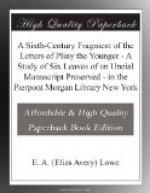Budaeus, on the other hand, is not an editor. He is a vastly interested reader of Pliny, frequently commenting on the subject-matter or calling attention to it by marginal signs. As for the text, he generally finds Beroaldus good enough. He corrects misprints, makes a conjecture now and then, or adopts one of Catanaeus, and, besides supplementing the missing portions with transcripts made for him from the Parisinus, inserts numerous variants, some of which indubitably come from that manuscript.[66] In the present section, occupying 251 lines in _{Pi}_, there is only one reading of the Parisinus—a false reading, it happens—that seems to Budaeus worth recording. Compared with what Aldus gleaned from _{Pi}_, Budaeus’s extracts are insignificant. It is remarkable, for instance, that on a passage (65, 11) which, as the appended obelus shows, he must have read with attention, he has not added the very different reading of the Parisinus. Either, then, Budaeus did not consult the Parisinus with care, or he did not think the great majority of its readings preferable to the text of Beroaldus, or, as I think may well have been the case, he had neither the manuscript itself nor an entire copy of it accessible at the time when he added his variants in his combined edition of Beroaldus and Avantius.[67]
[Footnote 66: See Merrill, “Zur fruehen Ueberlieferungsgeschichte des Briefwechsels zwischen Plinius und Trajan,” in Wiener Studien XXXI (1909), p. 257; C.P. II, p. 154; XIV, p. 30 f. Two examples (216, 23 and 227, 18) will be noted in plate XVII a.]
[Footnote 67: Certain errors of the scribe who wrote the additional pages in the Bodleian book warrant the surmise that he was copying not the Parisinus itself, but some copy of it. Thus in 227, 14 (see plate XVII b) we find him writing Tamen for tum, Budaeus correcting this error in the margin. A scribe is of course capable of anything, but with an uncial tum to start from, tamen is not a natural mistake to commit; it would rather appear that the scribe falsely resolved a minuscule abbreviation.]
But I do not mean to present here a final estimate of Budaeus; for that, I hope, we may look to Professor Merrill. Nor do I particularly blame Budaeus for not constructing a new text from the wealth of material disclosed in the Parisinus. His interests lay elsewhere; suos quoique mos. What I mean to say, and to say with some conviction, is that for the portion of text included in our fragment, the evidence of that fragment, coupled with that of B and F, shows that as a witness to the ancient manuscript Aldus is overwhelmingly superior to either Budaeus or any of the ancient editors.




